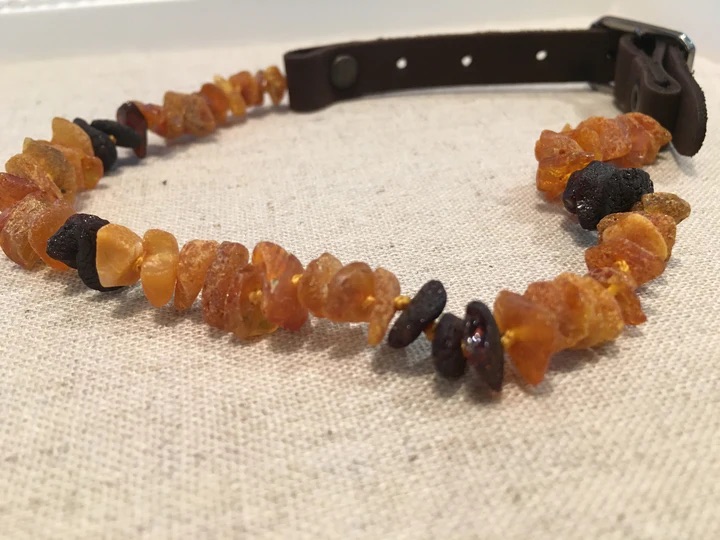As pet owners, we always want to keep our furry friends safe and comfortable, especially during the warmer months when ticks and other pests are more active. While traditional tick prevention methods, like chemical treatments, are effective, many pet parents are increasingly seeking natural alternatives. One such solution gaining popularity is the amber dog collar—a simple yet powerful tool that may help repel ticks and other pests. But how exactly does it work? Let’s dive into the benefits of amber collars and explore why they might be the right choice for your dog.
What Are Amber Dog Collars?
Amber dog collars are made from natural Baltic amber, a fossilized tree resin that’s been used for centuries due to its healing properties. The amber is often polished and strung together to create a collar that’s both stylish and functional. These collars are not just aesthetically pleasing—they’re believed to have the unique ability to help repel ticks and other insects naturally.
How Do Amber Collars Repel Ticks?
The secret behind amber’s tick-repelling power lies in the natural chemical compounds found in the resin. When amber is worn against a dog’s skin, it generates a very mild static charge. This charge can disrupt the sensory mechanisms of ticks and other parasites, causing them to avoid the dog altogether. It’s a non-toxic, chemical-free way to help reduce the risk of tick bites.
Amber contains succinic acid, a natural compound that is thought to have both insect-repelling and anti-inflammatory properties. While research is still ongoing, many pet owners swear by the effectiveness of amber collars in keeping ticks at bay.

Why Choose Amber Over Chemical Treatments?
- Chemical-Free Protection
Traditional tick collars often contain chemicals such as pyrethroids or permethrin, which can be harmful to your dog if ingested or if they come into contact with the skin. Amber collars, on the other hand, offer a completely natural alternative. They don’t involve any harmful pesticides or chemicals, making them a safer choice for both your pet and the environment. - Non-Toxic for Humans and Pets
Unlike chemical tick treatments, which can cause skin irritation, allergic reactions, or even toxicity in some pets, amber collars are generally safe. They provide peace of mind to pet owners who prefer natural and non-invasive solutions. - A Stylish Accessory
Besides being effective, amber collars are aesthetically pleasing. The warm, golden hues of the amber make for a stylish accessory that complements your dog’s natural beauty. You can choose from a variety of designs, making it easy to find one that suits your pet’s personality. - Long-Lasting Effectiveness
An amber collar is not a one-time-use item. With proper care, an amber collar can last for months, providing long-lasting protection. Unlike sprays and topical treatments, you don’t have to apply or reapply anything—simply put the collar on your dog, and it works continuously. - Eco-Friendly Option
Amber is a natural product, and the process of collecting and making amber collars is relatively low-impact on the environment. If you’re an eco-conscious pet owner, choosing an amber collar is a way to keep your dog safe while minimizing your carbon footprint.
What to Consider When Using Amber Collars
- Placement is Key
To ensure maximum effectiveness, the amber collar should be worn directly against the dog’s skin. The closer the collar is to the skin, the better it can produce the mild static charge needed to repel ticks. - Not a One-Stop Solution
While amber collars are effective, they may not offer 100% protection against ticks. For the best results, it’s advisable to combine the collar with other tick prevention strategies, such as regularly checking your dog for ticks after walks, using tick-repellent sprays, or keeping your dog away from heavily wooded areas. - Quality Matters
Not all amber collars are created equal. Make sure to buy high-quality, genuine Baltic amber collars from reputable sellers such as Baltic Essentials to ensure you’re getting the real deal. Fake or low-quality amber may not have the same tick-repelling properties.
Are Amber Dog Collars Right for Your Dog?
Amber dog collars offer a natural, effective, and stylish way to help keep ticks at bay. While they may not completely eliminate the risk of ticks, they are a valuable tool for preventing infestations, especially when combined with other preventive measures. For pet owners seeking a chemical-free solution, amber collars offer a great alternative that works with nature rather than against it.
As with any new pet product, it’s important to monitor your dog’s response and consult with your veterinarian to ensure the collar is a good fit for your pet’s health and needs. If you’re looking for a gentle yet effective way to help protect your dog from ticks, an amber dog collar may just be the perfect solution.
Conclusion
Tick prevention doesn’t have to involve harsh chemicals. Amber dog collars provide a natural, safe, and stylish option to keep your dog free from ticks while giving you peace of mind. Whether you’re concerned about chemicals or just looking for a natural solution, amber collars are a promising option to explore. Keep your dog safe, comfortable, and pest-free with the timeless power of amber!


